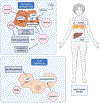Endocrine-disrupting compounds and metabolomic reprogramming in breast cancer
- PMID: 37598318
- PMCID: PMC10840637
- DOI: 10.1002/jbt.23506
Endocrine-disrupting compounds and metabolomic reprogramming in breast cancer
Abstract
Endocrine-disrupting chemicals pose a growing threat to human health through their increasing presence in the environment and their potential interactions with the mammalian endocrine systems. Due to their structural similarity to hormones like estrogen, these chemicals can interfere with endocrine signaling, leading to many deleterious effects. Exposure to estrogenic endocrine-disrupting compounds (EDC) is a suggested risk factor for the development of breast cancer, one of the most frequently diagnosed cancers in women. However, the mechanisms through which EDCs contribute to breast cancer development remain elusive. To rapidly proliferate, cancer cells undertake distinct metabolic programs to utilize existing nutrients in the tumor microenvironment and synthesize macromolecules de novo. EDCs are known to dysregulate cell signaling pathways related to cellular metabolism, which may be an important mechanism through which they exert their cancer-promoting effects. These altered pathways can be studied via metabolomic analysis, a new advancement in -omics technologies that can interrogate molecular pathways that favor cancer development and progression. This review will summarize recent discoveries regarding EDCs and the metabolic reprogramming that they may induce to facilitate the development of breast cancer.
Keywords: bisphenols; breast cancer; endocrine-disrupting compounds; metabolomics; phthalates; zeranol.
© 2023 The Authors. Journal of Biochemical and Molecular Toxicology published by Wiley Periodicals LLC.
Conflict of interest statement
Declaration of Interest
The authors declare no conflict of interest. The content is solely the responsibility of the authors and does not necessarily represent the official views of the National Institutes of Health.
Figures




References
-
- Yager JD and Davidson NE, Estrogen carcinogenesis in breast cancer. N Engl J Med, 2006. 354(3): p. 270–82. - PubMed
-
- Siegel RL, et al., Cancer statistics, 2022. CA: A Cancer Journal for Clinicians, 2022. 72(1): p. 7–33. - PubMed
-
- Lichtenstein P, et al., Environmental and Heritable Factors in the Causation of Cancer — Analyses of Cohorts of Twins from Sweden, Denmark, and Finland. New England Journal of Medicine, 2000. 343(2): p. 78–85. - PubMed
Publication types
MeSH terms
Substances
Grants and funding
LinkOut - more resources
Full Text Sources
Medical

